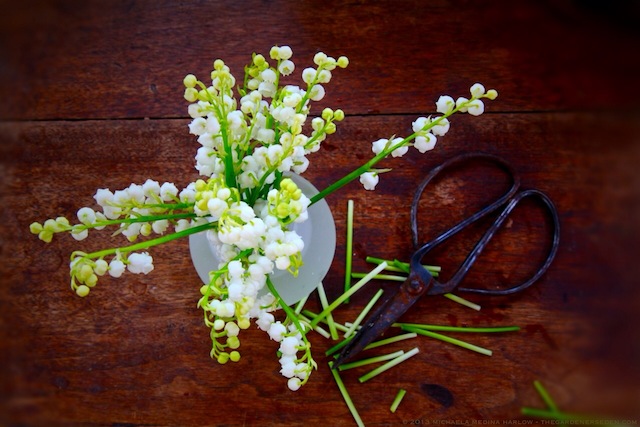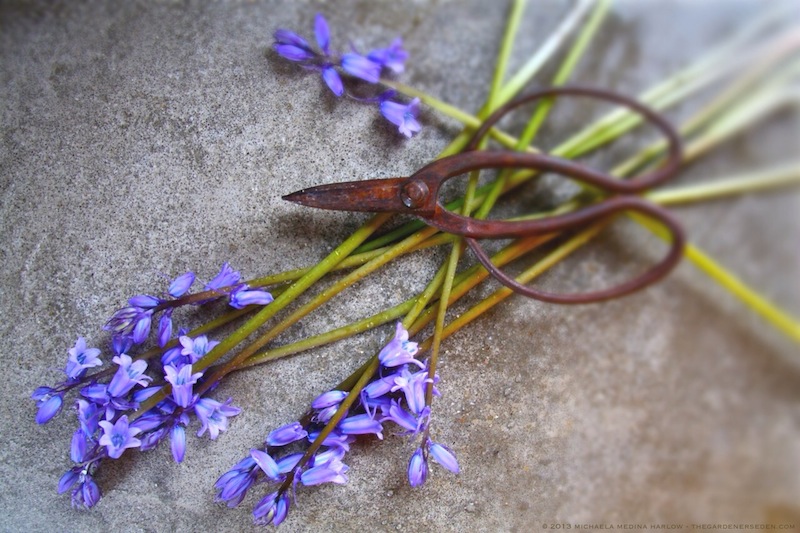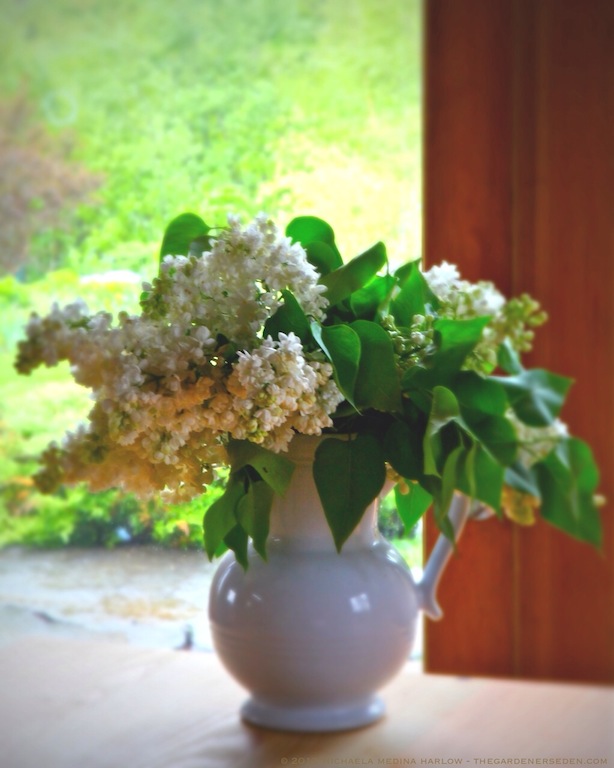The Alluring Scent of Lila & Muguet: Treasures Lost & Found in the Rain. . .
 Â Muguet, the Fragrance of May (Convallaria majalis)
 Muguet, the Fragrance of May (Convallaria majalis)
Oh, how I wish there were a way to bottle the sweet perfume of a rainy May evening. French lilac, lily-of-the-valley, Spanish and English bluebells, daphne, viburnum, violet and damp moss; the heady fragrance of springtime swirling about in dusk’s chilly air. Alas, with no way to truly preserve it, I’ve resolved to indulge in May’s beautiful aroma twenty-four hours a day, by filling every vase and vessel with freshly cut flowers.
And while out gathering lily-of-the-valley between springtime showers, I made an unanticipated, happy discovery. A favorite pair of Japanese gardening shears —presumed lost in a moment of careless distraction, last autumn— lay partially concealed amongst the muguet; camouflaged by blackened compost and umber leaf mold. Reclaimed in the nick of time, with a bit of oil and a whetstone rub, they’ll soon be no worse for wear. In this moment, I’ll delight in their rust-stained beauty; complement to the bluebell. Treasures lost and found in the rain.
 Spanish Bluebells (Hyacinthoides hispanica, aka Scilla hispanica)Â
Spanish Bluebells (Hyacinthoides hispanica, aka Scilla hispanica)Â
 Â French White Lilac (Syringa vulgaris ‘Mme. Lemoine’)
 French White Lilac (Syringa vulgaris ‘Mme. Lemoine’)
 Lily-of-the-Valley (Convallaria majalis)
Lily-of-the-Valley (Convallaria majalis)
Photography & Text â“’ Michaela Medina Harlow/The Gardener’s Eden. All images, articles and content on this site (with noted exceptions), are the original, copyrighted property of The Gardener’s Eden and may not be reposted, reproduced or used in any way without prior written consent. Contact information is in the left side bar. Please do not take my photographs without asking first. Thank you!Â
Do you enjoy The Gardener’s Eden? You can help support this site by shopping through affiliate links. A small percentage of each sale will be paid to this site, helping to cover web hosting and maintenance costs. Thank you so much for your support!

4 Replies to “The Alluring Scent of Lila & Muguet: Treasures Lost & Found in the Rain. . .”
Comments are closed.

Too easy to get distracted while in our gardens! I’ve been known to forget piles of mail in the grass next to a garden that needed weeding on the way back from the mailbox. Glad you found your shears.
And yes, the scent of spring is heady, for sure. Sometimes it seems that once brought indoors, the scents are never quite right. They become a little too much for the space or smell like they’re hurrying to decay after I’ve cut them, or not proportioned correctly with other scents. As if by the time I’ve got them in vases, there’s already a melancholy about them, nostalgia for what they smelled like outdoors. But I still bring them in and wish I could make the dizzy outdoor scent last a little longer.
We had heard that Spanish blue bells (bells all around the upright stem) had no particular scent as opposed to proper English blue bells (bells on one side of arching stem). Is there any truth to this? The former seem easier to come by but we have been avoiding them for the latter.
Hello there, Yes, the English Bluebell (Scilla non-scripta or as it is now known, Hyacinthoides non-scripta), is without a doubt the more fragrant of the wood hyacinths. Even within the native English Bluebell species (the English native is a deep, violet blue and yes, small, nodding blossoms on one side), the scent does vary quite a bit depending upon cultural conditions (and the gardener’s nose). And yes, although it isn’t nearly as strong, there does exist a delicate fragrance to some of the heirloom Spanish Bluebells (Scilla hispanica) as well. Hyaninthoides cultivars —with colors ranging from blue, violet, pink and white— also vary quite a bit in characteristics; including the scent. Interestingly, the hybrids —called Hyacinthoides x massartiana— seem to have lost considerable amount of fragrance as the colors have expanded. Although most of the bluebells in my garden are Scilla non-scripta, I do have both Scilla non-scripta and Scilla hispanica as well as hybrids. If you are interested in creating a fragrant woodland of English Bluebells —like the native bluebell woods in Great Britain— I would stick to the Hyacinthoides non-scripta aka S. non-scripta.
Good question! M
Hi Jen, I find that now that I’ve raised the topic of floral fragrance, all sorts of interesting conversations are happening on the phone, at the dinner table and on various social networks! It seems that our olfactory senses, opinions and attached memories are very strong indeed! I can remember a very cloying bouquet at my grandmother’s house when I was a child. It contained hybrid Hyacinth, among other springtime bulbs. To this day, although I love the scent of Hyacinth out-of-doors, I find the fragrance overpowering in a small room.
Interestingly, I can never get enough of certain fragrances —usually the delicate ones— which may be why I notice and prefer the slightly spicy Viburnums, Daphnes and the incomparably alluring, ever-coquettish Viola odorata.
I love this discussion! What a great thing to think about. :) xo M